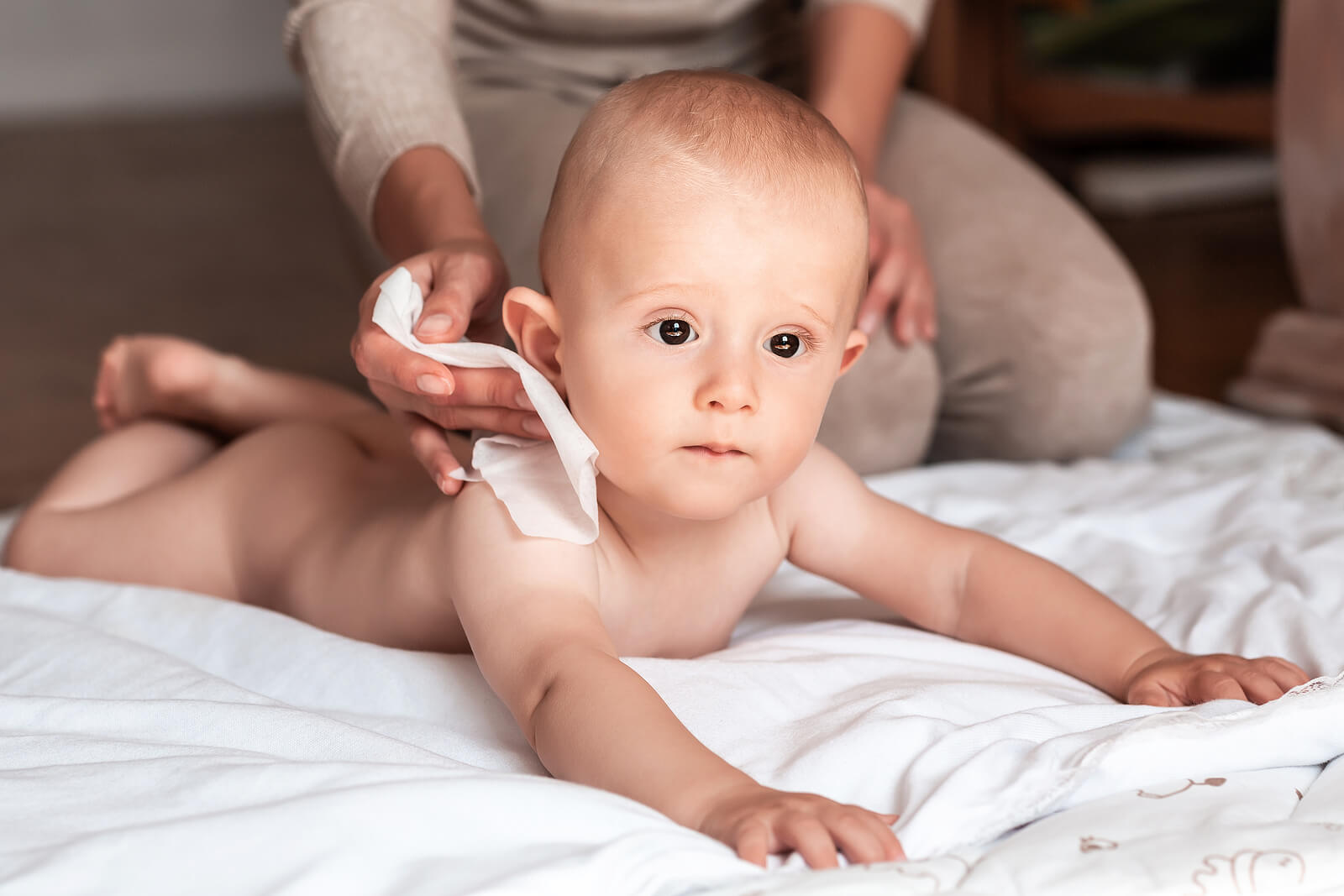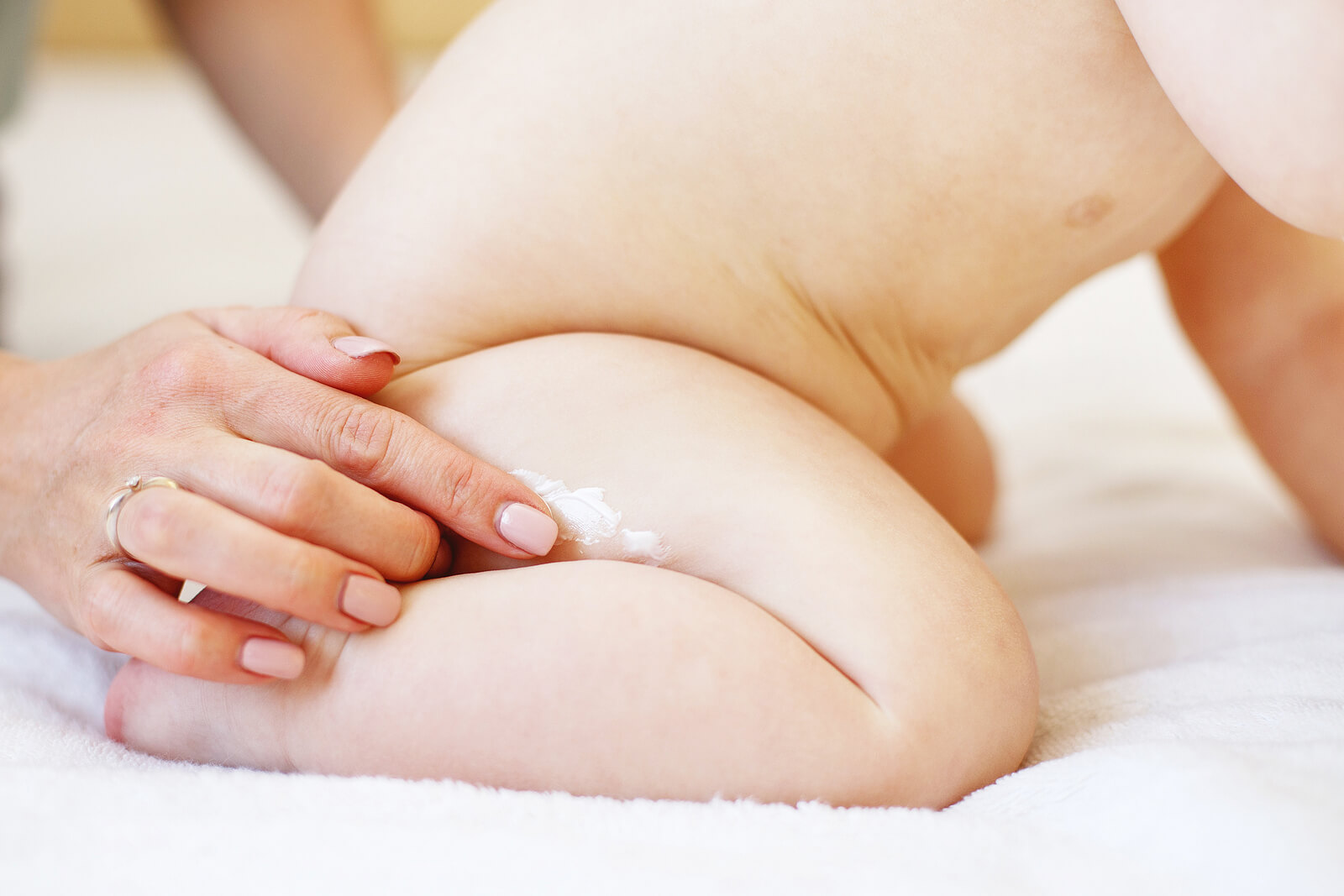Keys to Keeping Your Baby's Skin Moisturized

Keeping a baby’s skin moisturized is one of the many concerns of parents. The cutaneous barrier of their skin isn’t yet fully developed and doesn’t yet fulfill the functions it fulfills in the skin of an adult.
Likewise, the care and hydration of a baby’s skin contribute to avoiding dermatitis, irritations, and later discomfort. Although a good moisturizing cream or lotion would be effective in this aspect, there are recommendations to take into account and keep the baby’s skin hydrated and healthy.
How to keep your baby’s skin hydrated?
The baby’s growth, aggressive external agents, or temperature changes are some of the factors that can cause the baby’s skin to be dry.

Adequate moisturizing
According to studies by Pediatric Dermatology, babies, at birth, have drier skin than normal. Therefore, the use of emollients helps to keep the baby’s skin moisturized and protects the integrity of the skin surface.
Properly used and appropriate moisturizers can improve, protect, and preserve the skin barrier of a baby’s skin by incorporating lipids and water into the skin surface. Therefore, it aids and inhibits water loss.
One of the ideal times to apply moisturizing products is after bathing. The skin is very receptive to any product applied to it.
Sun protection
Babies under 6 months of age shouldn’t be exposed to sun rays because their skin is more sensitive than that of adults. They can even burn more easily and develop dehydration.
In addition, not only is sun exposure prohibited but sun protection shouldn’t be applied to babies under 6 months of age.
When choosing the sun protection factor, a broad-spectrum sunscreen should be chosen that provides coverage against UVA and UVB rays with a protection factor greater than or equal to 50. It should also be reapplied every 2 hours because it loses its effectiveness.
Read also: The Best Sunscreens for Babies and Children
Correct clothing
Just as certain products can cause irritation or allergic dermatitis on the baby’s skin, so can certain types of clothing fabrics.
Your baby should use clothing made of 100% cotton or other natural fabrics. You should also opt for clothes that don’t contain chemical products in their manufacturing.
Some clothes have their brand label or certain seams that may be uncomfortable for the baby. Therefore, you should remove or cut them to prevent possible dermatitis.
Baths and showers to keep baby’s skin hydrated
Bathing babies isn’t necessary every day. On the contrary, on those days when bathing isn’t done, just wiping with a damp cloth will suffice.
You don’t have to use soap for this type of hygiene. However, if soap is used, it should be rinsed correctly to avoid subsequent irritation.
The water temperature should be warm and extreme temperatures should be avoided so as not to generate thermal deregulation in the skin.
You may be interested in: The Ideal Temperature for a Baby’s Bath

Soaps and oils for hygiene
A baby’s skin is very sensitive and isn’t fully developed at birth. For this reason, the skin barrier function that it must fulfill isn’t yet in place. Therefore, the use of any type of soap or oil can cause alterations in the pH levels of the skin and trigger irritating processes, eczema, or itching in the baby.
When choosing a soap or oil for a baby’s bath and hygiene, certain precautions and care should be taken. Likewise, a review in the Journal of the European Academy of Dermatology and Venereology recommends the use of neutral, mild soaps or syndet soaps.
Humidity in the environment
In winter, babies’ skin tends to become dehydrated due to the use of heaters in the home. Therefore, to avoid skin dryness, the use of humidifiers is recommended. They keep the environment cool, the skin moisturized, and help emollient products to be even more effective.
What’s important to remember in order to keep the baby’s skin moisturized?
Babies’ skin is more sensitive and delicate because it hasn’t yet fully developed. Consequently, it requires certain care and hygiene processes to promote healthy skin.
As much as possible, the integrity and hydration of the skin should be maintained to avoid possible dermatitis. Therefore, it’s best to take into account aspects such as moisturizing, frequency of baths, and the use of certain products.
Keeping a baby’s skin moisturized is one of the many concerns of parents. The cutaneous barrier of their skin isn’t yet fully developed and doesn’t yet fulfill the functions it fulfills in the skin of an adult.
Likewise, the care and hydration of a baby’s skin contribute to avoiding dermatitis, irritations, and later discomfort. Although a good moisturizing cream or lotion would be effective in this aspect, there are recommendations to take into account and keep the baby’s skin hydrated and healthy.
How to keep your baby’s skin hydrated?
The baby’s growth, aggressive external agents, or temperature changes are some of the factors that can cause the baby’s skin to be dry.

Adequate moisturizing
According to studies by Pediatric Dermatology, babies, at birth, have drier skin than normal. Therefore, the use of emollients helps to keep the baby’s skin moisturized and protects the integrity of the skin surface.
Properly used and appropriate moisturizers can improve, protect, and preserve the skin barrier of a baby’s skin by incorporating lipids and water into the skin surface. Therefore, it aids and inhibits water loss.
One of the ideal times to apply moisturizing products is after bathing. The skin is very receptive to any product applied to it.
Sun protection
Babies under 6 months of age shouldn’t be exposed to sun rays because their skin is more sensitive than that of adults. They can even burn more easily and develop dehydration.
In addition, not only is sun exposure prohibited but sun protection shouldn’t be applied to babies under 6 months of age.
When choosing the sun protection factor, a broad-spectrum sunscreen should be chosen that provides coverage against UVA and UVB rays with a protection factor greater than or equal to 50. It should also be reapplied every 2 hours because it loses its effectiveness.
Read also: The Best Sunscreens for Babies and Children
Correct clothing
Just as certain products can cause irritation or allergic dermatitis on the baby’s skin, so can certain types of clothing fabrics.
Your baby should use clothing made of 100% cotton or other natural fabrics. You should also opt for clothes that don’t contain chemical products in their manufacturing.
Some clothes have their brand label or certain seams that may be uncomfortable for the baby. Therefore, you should remove or cut them to prevent possible dermatitis.
Baths and showers to keep baby’s skin hydrated
Bathing babies isn’t necessary every day. On the contrary, on those days when bathing isn’t done, just wiping with a damp cloth will suffice.
You don’t have to use soap for this type of hygiene. However, if soap is used, it should be rinsed correctly to avoid subsequent irritation.
The water temperature should be warm and extreme temperatures should be avoided so as not to generate thermal deregulation in the skin.
You may be interested in: The Ideal Temperature for a Baby’s Bath

Soaps and oils for hygiene
A baby’s skin is very sensitive and isn’t fully developed at birth. For this reason, the skin barrier function that it must fulfill isn’t yet in place. Therefore, the use of any type of soap or oil can cause alterations in the pH levels of the skin and trigger irritating processes, eczema, or itching in the baby.
When choosing a soap or oil for a baby’s bath and hygiene, certain precautions and care should be taken. Likewise, a review in the Journal of the European Academy of Dermatology and Venereology recommends the use of neutral, mild soaps or syndet soaps.
Humidity in the environment
In winter, babies’ skin tends to become dehydrated due to the use of heaters in the home. Therefore, to avoid skin dryness, the use of humidifiers is recommended. They keep the environment cool, the skin moisturized, and help emollient products to be even more effective.
What’s important to remember in order to keep the baby’s skin moisturized?
Babies’ skin is more sensitive and delicate because it hasn’t yet fully developed. Consequently, it requires certain care and hygiene processes to promote healthy skin.
As much as possible, the integrity and hydration of the skin should be maintained to avoid possible dermatitis. Therefore, it’s best to take into account aspects such as moisturizing, frequency of baths, and the use of certain products.
All cited sources were thoroughly reviewed by our team to ensure their quality, reliability, currency, and validity. The bibliography of this article was considered reliable and of academic or scientific accuracy.
- Blume-Peytavi U, Cork MJ, Faergemann J, Szczapa J, Vanaclocha F, Gelmetti C. Bathing and cleansing in newborns from day 1 to first year of life: recommendations from a European round table meeting. J Eur Acad Dermatol Venereol. 2009 Jul;23(7):751-9. doi: 10.1111/j.1468-3083.2009.03140.x. PMID: 19646134.
- Saijo S, Tagami H. Dry skin of newborn infants: functional analysis of the stratum corneum. Pediatr Dermatol. 1991 Jun;8(2):155-9. doi: 10.1111/j.1525-1470.1991.tb00308.x. PMID: 1923986.
- Julian E, Palestro AM, Thomas JA. Pediatric Sunscreen and Sun Safety Guidelines. Clin Pediatr (Phila). 2015 Oct;54(12):1133-40. doi: 10.1177/0009922815591889. Epub 2015 Jun 29. PMID: 26130395.
- Mendes BR, Shimabukuro DM, Uber M, Abagge KT. Critical assessment of the pH of children’s soap. J Pediatr (Rio J). 2016 May-Jun;92(3):290-5. doi: 10.1016/j.jped.2015.08.009. Epub 2016 Feb 1. PMID: 26844391.
- Goad N, Gawkrodger DJ. Ambient humidity and the skin: the impact of air humidity in healthy and diseased states. J Eur Acad Dermatol Venereol. 2016 Aug;30(8):1285-94. doi: 10.1111/jdv.13707. Epub 2016 Jun 15. PMID: 27306376.
This text is provided for informational purposes only and does not replace consultation with a professional. If in doubt, consult your specialist.








